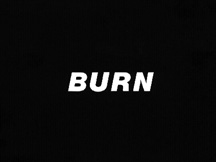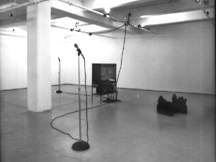- MAIN INDEX | ARTIST INDEX
| September 2 - 20, 1980 John McEwen
| |
 John McEwen, "Burn", invitation, 1980. 18K |  John McEwen, installation view of "Burn", 1980, Photo Peter MacCallum. 18K |
|
Understanding Caliban
John Bentley Mays I do not understand John McEwen's installation at Mercer Union, 29 Mercer, which is on view until Sept. 20. But this is what's there: clamped on the west wall, three large iron slabs. Near the top of the left hand one McEwen has drilled the word - mirrors; at the top of the middle one, veil; and of the right-hand one, ideal. At the bottom of each - appears the phrase of tears. Near the door to the exhibition space, there is a little shin-high iron platform supported by two oblong iron blocks. On the platform, McEwen has drilled the outline of a skull. The cords from two mike-stands, in two quarters of the room, lead into a box, which in turn feeds a large TV set. Right across the middle of the screen a bright line wiggles and scrawls in; response to the noise picked up by the two mikes. Between all these things there are gallons of empty space. I don't get it. So why try to talk about it? Because McEwen is not going to go away. He is sure to continue showing his enigmatic sculptures in galleria and museums throughout the country, and art critics will go on trying to snare them into the bear-trap of art-world meaningfulness. Let's take the McEwen shows I've seen this year. First: at the Vancouver Art Gallery, in January. That silhouette of a hound, flame cut out of solid steel and chained to a long running cable, was right between me and the Eskimo photographs. It's been bothering me ever since -- not being able to get into the photo gallery without passing the dog, then not being able to look at the photographs without thinking about that strange sculpture I did not understand, waiting outside. Then there were those pieces in Ottawa, at the Pluralities show. The steel cut-out of a rabbit, the outline of a bird punched from a thick disc of solid steel. The thought-deflant density of the steel versus the kindergarten imagery of rabbit, bird, dog. The power of the material, the whimsy of the depiction--what does it add up to? These products of McEwen's old fashioned blacksmith shop near Barrie aren't sculptures, at least of the modernist, formal variety. There hasn't, for example, been an elimination of everything except what emerges from the plastic, volumetric properties of the material. There's certainly no formal independence - (á la Doug Bentham) or even much critical distance (á la Henry Moore), from things in the world, such as dogs and birds. What about the fact that these works allude so openly to figures in the world? Doesn't this make them statuary, and not sculpture in the modern sense of the word? Let's assume so, and see where we get. A life-sized rabbit cut from a slab of iron does seem to embody an old duality of statuary: warm flesh expressed in cold marble, flowing garments depicted by frozen bronze, and so on. But McEwen isn't a maker of yard ornaments, any more than he's a creator of abstract modernist sculptures. His pieces, such as the rabbit, are impure things that mix both sculptural and statuary concerns: they're chunks of steel, true to being just steel. And they work as depictions as well--not illusionistic statuary, but just silhouettes, so as never to let you forget the radical physical density of the steel from which the outlines have been cut. McEwen's fabrications stand between two points of artistic attention: the real thing in the room (steel), and the wild thing alluded to (rabbit). Now what about the Mercer installation? There is a strongly structural, material (if incomprehensible) integrity to the work, as there should be in good sculpture. There is also statuary's inbringing of imagery: language, symbolism (the skull outline) and vernacular architectural imagery (the platform) -- things that are materially "outside" sculpture -- make guest appearances. Even the Mercer social ambience is, in a sense, brought into the work by the microphones, which make the surrounding noises visible. If I've got it straight, this all means that McEwen's very interesting installation -- like his rabbit -- should be read as a sort of artistic Caliban, misbegotten by sculpture on a statuary mother. Which isn't saying I understand it. Which is saying I don't.
| |